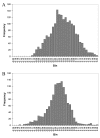Mathematical design of prokaryotic clone-based microarrays
- PMID: 16191193
- PMCID: PMC1262695
- DOI: 10.1186/1471-2105-6-238
Mathematical design of prokaryotic clone-based microarrays
Abstract
Background: Clone-based microarrays, on which each spot represents a random genomic fragment, are a good alternative to open reading frame-based microarrays, especially for microorganisms for which the complete genome sequence is not available. Since the generation of a genomic DNA library is a random process, it is beforehand uncertain which genes are represented. Nevertheless, the genome coverage of such an array, which depends on different variables like the insert size and the number of clones in the library, can be predicted by mathematical approaches. When applying the classical formulas that determine the probability that a certain sequence is represented in a DNA library at the nucleotide level, massive amounts of clones would be necessary to obtain a proper coverage of the genome.
Results: This paper describes the development of two complementary equations for determining the genome coverage at the gene level. The first equation predicts the fraction of genes that is represented on the array in a detectable way and cover at least a set part (the minimal insert coverage) of the genomic fragment by which these genes are represented. The higher this minimal insert coverage, the larger the chance that changes in expression of a specific gene can be detected and attributed to that gene. The second equation predicts the fraction of genes that is represented in spots on the array that only represent genes from a single transcription unit, which information can be interpreted in a quantitative way.
Conclusion: Validation of these equations shows that they form reliable tools supporting optimal design of prokaryotic clone-based microarrays.
Figures




Similar articles
-
Long versus short oligonucleotide microarrays for the study of gene expression in nonhuman primates.J Neurosci Methods. 2006 Apr 15;152(1-2):179-89. doi: 10.1016/j.jneumeth.2005.09.007. Epub 2005 Oct 25. J Neurosci Methods. 2006. PMID: 16253343
-
Large scale real-time PCR validation on gene expression measurements from two commercial long-oligonucleotide microarrays.BMC Genomics. 2006 Mar 21;7:59. doi: 10.1186/1471-2164-7-59. BMC Genomics. 2006. PMID: 16551369 Free PMC article.
-
Design and testing of 'genome-proxy' microarrays to profile marine microbial communities.Environ Microbiol. 2008 Feb;10(2):506-21. doi: 10.1111/j.1462-2920.2007.01471.x. Epub 2007 Nov 19. Environ Microbiol. 2008. PMID: 18028413
-
Utilizing tiling microarrays for whole-genome analysis in plants.Plant J. 2008 Feb;53(4):636-44. doi: 10.1111/j.1365-313X.2007.03320.x. Plant J. 2008. PMID: 18269573 Review.
-
Hybridization of genomic DNA to microarrays: a challenge for the analysis of environmental samples.J Microbiol Methods. 2007 May;69(2):242-8. doi: 10.1016/j.mimet.2006.11.007. Epub 2006 Dec 26. J Microbiol Methods. 2007. PMID: 17188770 Review.
Cited by
-
Mixed-species genomic microarray analysis of fecal samples reveals differential transcriptional responses of bifidobacteria in breast- and formula-fed infants.Appl Environ Microbiol. 2009 May;75(9):2668-76. doi: 10.1128/AEM.02492-08. Epub 2009 Mar 13. Appl Environ Microbiol. 2009. PMID: 19286790 Free PMC article.
References
-
- Askenazi M, Driggers EM, Holtzman DA, Norman TC, Iverson S, Zimmer DP, Boers ME, Blomquist PR, Martinez EJ, Monreal AW, Feibelman TP, Mayorga ME, Maxon ME, Sykes K, Tobin JV, Cordero E, Salama SR, Trueheart J, Royer JC, Madden KT. Integrating transcriptional and metabolite profiles to direct the engineering of lovastatin-producing fungal strains. Nat Biotechnol. 2003;21:150–156. doi: 10.1038/nbt781. - DOI - PubMed
-
- Akopyants NS, Clifton SW, Martin J, Pape D, Wylie T, Li L, Kissinger JC, Roos DS, Beverley SM. A survey of the Leishmania major Friedlin strain V1 genome by shotgun sequencing: a resource for DNA microarrays and expression profiling. Mol Biochem Parasitol. 2001;113:337–340. doi: 10.1016/S0166-6851(01)00227-4. - DOI - PubMed
Publication types
MeSH terms
LinkOut - more resources
Full Text Sources
Molecular Biology Databases

